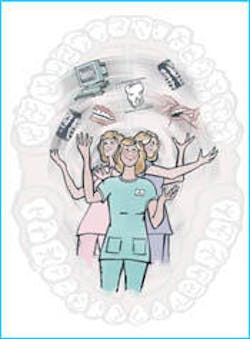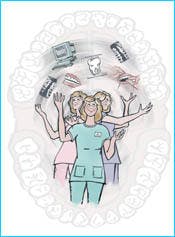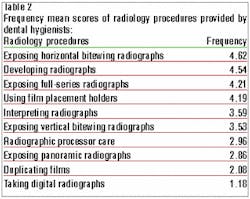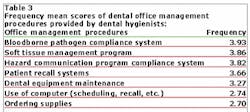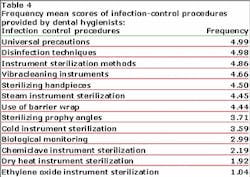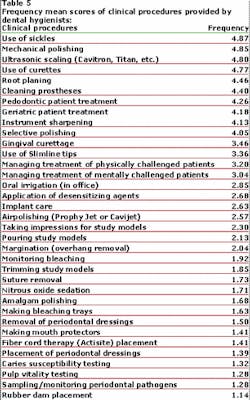Job descriptions (or at least what the boss thinks)
By Charla J.Lautar, RDH, PhD; Sandra J.Maurizio, RDH, MSEd; and Cynthia E. Heischmidt, RDH, PhD
Illinois study examines how employers view the duties of dental hygienists.
A recent study investigated dentists' perceptions about the services provided by dental hygienists. The data collected from 171 Illinois dentists suggested the perception that dental hygienists do not perform services associated with new advancements in treatment and technology. While the services may be limited by the availability of technology — such as computerized probing, intraoral video cameras, and digital radiography — dental educators must provide more continuing-education courses on contemporary advancements for practicing dentists and dental hygienists.
In this era of increased accountability, college and university faculty and administrators must meet demands of students, parents, and employers. The latter group desire reassurance that future employees already possess the skills necessary for the competitive business world. In order to ensure the safety of the public, health profession educators also have an ethical duty to provide the best possible educational programs, and they must evaluate graduates to ensure competency in providing treatment.
The curriculum of dental hygiene programs is guided by accreditation standards implemented by the American Dental Association Commission on Dental Accreditation. Accredited programs must meet specific criteria for curriculum, facilities, and staff. In addition, dental hygiene schools initiate ongoing assessment programs. This assessment can include the following:
- Students' passing rates on national board and licensure exams
- Alumni and employer surveys
- Length of time to complete degree
- Exit interviews with graduates
- Focus groups
- Portfolio assessments
In the field of dental hygiene, almost 90 percent of hygienists are employed in private dental offices. Therefore, an appropriate method of assessing dental hygienists' performance of specific procedures is to survey dentists who employ dental hygienists. For the study referred to above, researchers surveyed employers to investigate perceptions about the frequency of procedures performed by dental hygienists on their staffs.
The research, which was funded by the University Women's Professional Advancement at Southern Illinois University in Carbondale, involved developing a survey that was mailed to a list of 700 dentists.
The survey consisted of two sections. The first section asked demographic information about the employers, as well as employment data about dental hygienists. The second section listed 93 procedures in a Likert-scale format and asked the employers to indicate the frequency of performance for each item performed by dental hygienists. In addition, the survey contained a section for comments from the respondents.
When the survey was mailed in 1997, 171 dentists participated. The demographic section of the survey revealed the following about the participants:
- Nearly 80 percent were in general practice.
- 55 percent were in solo practice, a lower rate than reported in the ADA 1995 Survey of Dental Practice which indicated that more than two-thirds of all U.S. dentists are solo practitioners.
- 71 percent had been in practice for more than 10 years.
- 66 percent employed a dental hygienist. This statistic was similar to that of the ADA 1995 Survey of Dental Practice, which reported that 63 percent of independent dentists employed at least one dental hygienist.
- 43 percent employed a dental hygienist four-and-a-half to five days per week.
- 75 percent had employed a dental hygienist for 10 years or more.
Dentists also were asked about how well their own professional education prepared them for employing dental hygienists in their practices. Of the 114 dentists who answered this question, 29 (25 percent) said they were not prepared at all. Fifty (44 percent) indicated they were somewhat prepared, and 35 (30 percent) said they were very well-prepared.
Procedures performed
The dental hygiene procedures listed on the survey were divided into seven subdivisions: patient evaluation, radiology, dental office management, clinical skills, infection control, preventive care, and communication skills. Dentists were asked to rate the frequency of performance of procedures by any hygienist they employed.
Descriptive analysis of data for the Likert-scale items used mean scores and frequency percentages to report the performance of procedures.
The data suggested that dental hygienists performed with less frequency services that are associated with new advancements in treatment and technology. This trend was evident in all seven areas of the procedures included in the survey. The results for each of the seven subdivisions are represented in the tables accompanying this article.
Patient evaluation
Table 1 lists the mean scores for the frequency of each of the procedures included in the "patient evaluation" section. Dentists report that 93 percent of hygienists are performing medical history assessments on a daily basis. Gingival assessment (91 percent) and caries detection (83 percent) also are performed daily, according to the survey. Technological advancements, including computerized probing and computerized voice recording, were performed on a daily basis less than 5 percent of the time.
null
With each of the tables presented in this article, the higher the mean score, the more frequent the procedure is performed (5=highest frequency rating; 1=lowest frequency rating). When answering the survey, employers answered in the following manner:
- 5 indicated daily performance of a procedure
- 4 indicated weekly performance
- 3 indicated monthly performance
- 2 indicated 'seldom"
- 1 indicated 'never"
- 0 indicated uncertainty
Radiology
As anticipated, dentists reported that their dental hygienists expose horizontal bitewings (87 percent) and full-mouth series (62 percent) on a daily basis. Developing radiographs is performed on a daily basis by 83 percent of the hygienists. In contrast, digital radiographs are taken by only 10 percent of the dental hygienists, perhaps because that technology is not yet available in most dental offices. Table 2 describes the mean scores for frequency performance of radiology procedures.
null
Dental office management
In terms of office management procedures (Table 3), hygienists do not routinely perform these tasks. The ordering of supplies and use of the computer are seldom or never performed by 47 percent and 53 percent of the hygienists, respectively. The most frequently performed tasks in this area were soft tissue management (73 percent daily or weekly), bloodborne pathogen compliance system (66 percent daily or weekly), and hazard communication compliance system (67 percent daily or weekly).
null
Infection control
The data in Table 4 demonstrate that infection control procedures are frequently performed by dental hygienists. Dentists reported that on a daily basis dental hygienists are using instrument sterilization methods (94 percent), disinfection techniques (98 percent), universal precautions (99 percent), and vibracleaning instruments (91 percent).
null
Clinical skills
Data regarding performance of clinical skills is found in Table 5. Many of the clinical procedures are not provided by hygienists on a regular basis. The traditional dental hygiene skills of scaling and polishing were rated high; 85 to 93 percent of dentists reported performance on a daily basis. The procedures performed least frequently were rubber dam placement (92 percent never perform this service), pulp vitality testing (80 percent never perform), and fiber cord therapy (76 percent never perform).
null
Preventive care
Responding dentists rated dental hygienists high in regard to frequently performing preventive-care procedures (Table 6). Ninety-seven percent of dentists reported that their hygienists perform patient education on a daily basis. However, specific patient education with nutritional counseling is performed slightly less than monthly. Dental hygienists apply sealants less than weekly, and 19 percent of dentists said that their hygienists never apply sealants.
null
Communication skills
The data in Table 7 demonstrate a very high degree of frequency for communication skills. Seventy percent of dentists stated that their dental hygienists explain treatment options to patients daily.
null
The survey results indicate a disparity between what is performed clinically while enrolled in a dental hygiene educational program and what is performed in clinical practice. The findings suggest dental hygienists are underutilized in the dental office. Several reasons for this underutilization can be postulated. Many procedures may not be performed by dental hygienists due to the fact that the tasks are either not delegated to them, or they are not provided with sufficient time to perform them. Dentists may not be aware of the range of functions that dental hygienists are legally allowed and educationally prepared to perform. As a result, dentists do not delegate these procedures or may delegate tasks to other qualified office personnel. New legislation and changes in the various dental practice acts allow dental assistants to perform traditional dental hygiene procedures, such as sealants, topical fluorides, polishing, and supragingival scaling.
It would stand to reason that some services would have a lower rating due to the nature of the service. For example, because dental hygienists' primary functions are not in the management area, perhaps weekly or monthly performance would be expected.
In actuality, dental hygienists are taught a wide variety of tasks other than prophylaxis and home care techniques. The extent of these procedures depends on both the curriculum of dental hygiene programs and the legislative practice acts of the state where the dental hygienist receives his/her education.
Since they are underutilized, dental hygienists indicate that they have more career satisfaction when they have opportunities for a variety of tasks that employ all of their skills and knowledge.
Additionally, some offices may not possess the equipment needed to perform some of the listed procedures, or may not provide the services in their practices. The study acknowledged that the opportunity might not exist for performing all of the skills listed. As technologically advanced equipment becomes readily available in the private practice setting, these procedures may be delegated to dental hygienists with greater frequency.
It is possible that some of the newer technologies were not included in the educational programs of the dentists surveyed or the dental hygienists they employ. The findings reinforce the need for continuing-education courses both for dentists and dental hygienists.
It would appear that if dental students received a more thorough background of dental hygiene educational preparation, they would be better able to utilize their dental hygienists more efficaciously. As one responding dentist commented: "I do not employ a hygienist, and one of the main reasons I don't is I do not know how to incorporate a hygienist's functions into the office setting. I don't understand what they add to a practice without creating management problems of a timing and utilization nature."
Dental hygienists are educationally prepared to perform many patient-care procedures. But the Southern Illinois University survey suggests that dental hygienists are underutilized in dental offices. The reasons for this underutilization need further study.
With the new advancements in technology and treatment modalities delegated to dental hygienists, it is critical that continuing-education programs address these concerns. Dental schools should continue to provide opportunities where dentists work with dental hygienists so that the education and capabilities of dental hygienists is fully understood.
Charla J. Lautar, RDH, PhD, Sandra J. Maurizio, RDH, MSEd, and Cynthia E. Heischmidt, RDH, PhD, are instructors in the department of health-care professions at Southern Illinois University in Carbondale, Ill. Lautar can be contacted at (618) 453-7211 or [email protected].
References available upon request.
